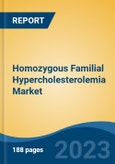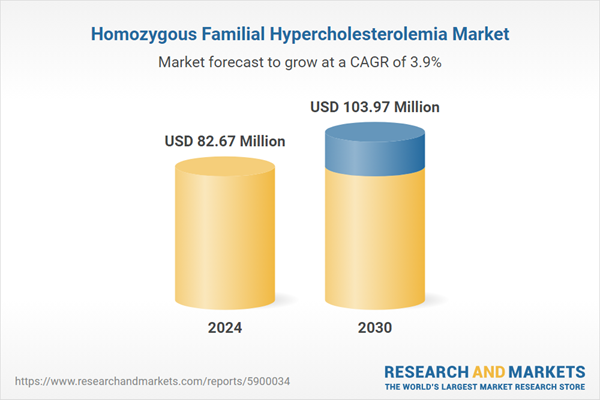Speak directly to the analyst to clarify any post sales queries you may have.
10% Free customizationThis report comes with 10% free customization, enabling you to add data that meets your specific business needs.
HoFH is an autosomal recessive disorder marked by abnormally high levels of low-density lipoprotein cholesterol (LDL-C) in the bloodstream, which leads to early and severe cardiovascular complications. Individuals affected by HoFH face significantly increased risks of heart attacks and other cardiovascular issues from a young age, necessitating lifelong, specialized medical care.
The HoFH market has seen significant growth in recent years, driven by breakthroughs in biotechnology, genetics, and pharmacology. Pharmaceutical leaders are actively investing in research and development to discover innovative therapies, such as monoclonal antibodies, gene therapies, and RNA-based treatments, to better manage and potentially cure this debilitating condition. These novel therapies show promise in dramatically lowering LDL-C levels and improving patients' quality of life.
Key Market Drivers
Advancements in Biotechnology and Genetics: Breakthroughs in biotechnology and genetics have been pivotal in propelling the growth of the HoFH market. Monoclonal antibodies like evinacumab (Evkeeza) have been instrumental in this progress. Approved by the U.S. FDA in February 2021, evinacumab inhibits angiopoietin-like 3 (ANGPTL3), a protein that obstructs lipid breakdown. By targeting ANGPTL3, evinacumab significantly reduces LDL-C levels in HoFH patients, decreasing the risk of cardiovascular complications. Clinical trials have confirmed its transformative potential in treating HoFH.Key Market Challenges
High Development Costs: A major challenge facing the HoFH market is the high development costs associated with creating therapies for this ultra-rare genetic disorder. HoFH affects roughly 1 in a million individuals globally, resulting in a small and geographically dispersed patient population. This scarcity complicates clinical trial recruitment and raises costs related to patient participation and data collection. Additionally, the complex nature of HoFH requires extensive research and multi-phase clinical trials, further driving up development costs.Key Market Trends
Telemedicine and Remote Monitoring: Telemedicine and remote monitoring technologies have become transformative in the management of HoFH, addressing the challenges posed by geographic and specialist access limitations. Telemedicine enables patients to consult with specialized healthcare providers remotely, ensuring timely and consistent care. Through telehealth platforms, healthcare professionals can monitor patient progress, suggest lifestyle changes, and adjust treatments as needed, reducing the need for in-person visits.Furthermore, remote monitoring technologies, including wearable devices and mobile applications, allow patients to track their cholesterol levels, medication adherence, and overall health. This continuous monitoring provides healthcare providers with real-time data, allowing for prompt interventions and minimizing the risk of cardiovascular events.
These advancements highlight the dynamic nature of the HoFH market, with significant potential for growth driven by innovation in therapeutic treatments and healthcare delivery.
Key Market Players
- AstraZeneca PLC
- Viatris Inc.
- Teva Pharmaceutical Industries Ltd.
- Accord Healthcare
- Changzhou Pharmaceutical Factory
- Regeneron Pharmaceuticals, Inc.
- Amryt Pharma plc
- Amgen Inc.
- Organon Global Inc.
- CMP Pharma
Report Scope:
In this report, the Global Homozygous Familial Hypercholesterolemia Market has been segmented into the following categories, in addition to the industry trends which have also been detailed below:Homozygous Familial Hypercholesterolemia Market, By Drug Class:
- Statins
- Cholesterol Absorption Inhibitors
- PCSK9 Inhibitors
- MTP Inhibitors
- ANGPTL3 Inhibitors
Homozygous Familial Hypercholesterolemia Market, By Route of Administration:
- Oral
- Parenteral
- Nasal
Homozygous Familial Hypercholesterolemia Market, By Technology:
- CRISPR-Cas9
- RNA Interference
- Nanoparticle-Based Therapies
Homozygous Familial Hypercholesterolemia Market, By Distribution Channel:
- Hospital Pharmacies
- Retail Pharmacies
- Online Pharmacies
Homozygous Familial Hypercholesterolemia Market, By Region:
- North America
- United States
- Canada
- Mexico
- Europe
- France
- United Kingdom
- Italy
- Germany
- Spain
- Asia-Pacific
- China
- India
- Japan
- Australia
- South Korea
- South America
- Brazil
- Argentina
- Colombia
- Middle East & Africa
- South Africa
- Saudi Arabia
- UAE
Competitive Landscape
Company Profiles: Detailed analysis of the major companies present in the Global Homozygous Familial Hypercholesterolemia Market.Available Customizations:
With the given market data, the publisher offers customizations according to a company's specific needs. The following customization options are available for the report.Company Information
- Detailed analysis and profiling of additional market players (up to five).
This product will be delivered within 1-3 business days.
Table of Contents
Companies Mentioned
- AstraZeneca PLC
- Viatris Inc.
- Teva Pharmaceutical Industries Ltd.
- Accord Healthcare
- Changzhou Pharmaceutical Factory
- Regeneron Pharmaceuticals, Inc.
- Amryt Pharma plc
- Amgen Inc.
- Organon Global Inc.
- CMP Pharma
Table Information
| Report Attribute | Details |
|---|---|
| No. of Pages | 184 |
| Published | April 2025 |
| Forecast Period | 2024 - 2030 |
| Estimated Market Value ( USD | $ 82.67 Million |
| Forecasted Market Value ( USD | $ 103.97 Million |
| Compound Annual Growth Rate | 3.8% |
| Regions Covered | Global |
| No. of Companies Mentioned | 10 |









